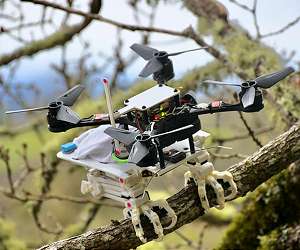Robots are already in space. From landers on the moon to rovers on Mars and more, robots are the perfect candidates for space exploration: they can bear extreme environments while consistently repeating the same tasks in exactly the same way without tiring.
Like robots on Earth, they can accomplish both dangerous and mundane jobs, from space walks to polishing a spacecraft’s surface. With space missions increasing in number and expanding in scientific scope, requiring more equipment, there’s a need for a lightweight robotic arm that can manipulate in environments difficult for humans.
However, the control schemes that can move such arms on Earth, where the planes of operation are flat, do not translate to space, where the environment is unpredictable and changeable. To address this issue, researchers in Harbin Institute of Technology’s School of Mechanical Engineering and Automation have developed a robotic arm weighing 9.23 kilograms – about the size of a one-year-old baby – capable of carrying almost a quarter of its own weight, with the ability to adjust its position and speed in real time based on its environment.
“In order to solve the problems of strict restrictions on the mass and size of the manipulator, as well as the high requirements for reliability and safety of the control method in space operation, we developed a light space manipulator and proposed a new control method,” said corresponding author Wenfu Xu, professor in Harbin Institute of Technology’s School of Mechanical Engineering and Automation and State Key Laboratory of Robotics and System.
Such a manipulator needs to exert constant force control when in operation.
“For the constant force control of a plane, the direction of control force is constant, but for a curved surface in an unknown environment, its normal vector is often changed in real time, so the traditional method would fail,” Xu said.
“In order to overcome this difficulty, we propose integral adaptive admittance control that can realize real-time correction of the desired position of the end of the manipulator so that it is in full contact and realizes constant force control.”
Compare it to a drawing a line on a piece of paper. When the paper is on a flat desktop, it’s much easier to maintain even pressure across the line. Drawing an identical line on a sheet of paper wrapped around a bouncing ball is much more difficult and requires specific calculations to understand the movement of the ball and how much pressure to exert based on the position of both the pen and the ball.
To keep the force control of the space manipulator constant, the researchers imposed a control method that removes the need for steady-state correction – a key component of control systems in known environments. Steady-state correction applies the potential error to the full movement, which eases problems when the environment is predictable.
For example, if the manipulator knows the desk’s surface is rough and strong pressure would cause the paper to rip, it can lighten the pressure of the pen to maintain a constant line. But when the surface is changing and unpredictable, maintaining a constant corrective state results in more errors, since not all corrections apply to all errors.
The researchers tested their control method for the lightweight manipulator and found that, even on an unknown surface, the mechanical arm could adjuster quicker than a traditionally controlled manipulator, resulting in a tracking effect steady enough for practical applications.
“Using the proposed light space manipulator and the integral adaptive admittance control method can solve practical problems on on-orbit servicing, such as space target capturing, on-orbital assemble, orbital repairing and so on,” Xu said.
According to Xu, this work can serve as a reference for the design of light manipulators in the future, while the control approach can be applied to the machining process of robotic surface grinders and polishers.
Contributors include Zhiwei Wu and Yongting Chen, School of Mechanical Engineering and Automation, Harbin Institute of Technology.
Research Report: A Light Space Manipulator with High Load-to-Weight Ratio: System Development and Compliance Control
Related Links
Harbin Institute of Technology
All about the robots on Earth and beyond!
|
We need your help. The SpaceDaily news network continues to grow but revenues have never been harder to maintain. With the rise of Ad Blockers, and Facebook – our traditional revenue sources via quality network advertising continues to decline. And unlike so many other news sites, we don’t have a paywall – with those annoying usernames and passwords. Our news coverage takes time and effort to publish 365 days a year. If you find our news sites informative and useful then please consider becoming a regular supporter or for now make a one off contribution. |
||
|
SpaceDaily Contributor $5 Billed Once credit card or paypal |
SpaceDaily Monthly Supporter $5 Billed Monthly paypal only |
|

![]()
Stanford engineers create perching bird-like robot
Stanford CA (SPX) Dec 02, 2021
Like snowflakes, no two branches are alike. They can differ in size, shape and texture; some might be wet or moss-covered or bursting with offshoots. And yet birds can land on just about any of them. This ability was of great interest to the labs of Stanford University engineers Mark Cutkosky and David Lentink – now at University of Groningen in the Netherlands – which have both developed technologies inspired by animal abilities.
“It’s not easy to mimic how birds fly and perch,” said William Rode … read more